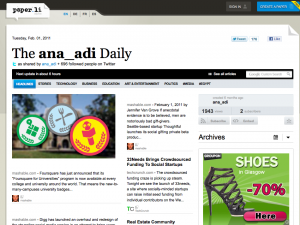 If you want your students to keep up with the latest news that the Internet is ranging about, anorexia tag related dailies generated on Paper.li are an appealing way to do. While the format will remind them of “old-school” newspapers, order the information within it will be fresh and up to date, complied from links shared on Twitter. This exercise will expose your students to the latest news in the area you teach  and immerse them into the online environments within which they’ll have to activate (or at least be aware of) in their future jobs. As the dailies have their content refreshed once a day, they present the advantage of the freshest information packaged in a challenge: unlike a traditional print daily, they have no archives. Therefore, information needs to be consumed/consulted on the day of publication.
If you want your students to keep up with the latest news that the Internet is ranging about, anorexia tag related dailies generated on Paper.li are an appealing way to do. While the format will remind them of “old-school” newspapers, order the information within it will be fresh and up to date, complied from links shared on Twitter. This exercise will expose your students to the latest news in the area you teach  and immerse them into the online environments within which they’ll have to activate (or at least be aware of) in their future jobs. As the dailies have their content refreshed once a day, they present the advantage of the freshest information packaged in a challenge: unlike a traditional print daily, they have no archives. Therefore, information needs to be consumed/consulted on the day of publication.
If you believe a Twitter-informed tag daily is not enough, throw in the readings mix some RSS feeds from blogs, traditional media outlets and blend them with a touch of research from your library or any online source of your preference (Google Scholar or Mendeley are good places to consider).
However, if you want your students to get their hands dirty at creating stories by using existing web content , Storify is in for the challenge. The newly launched service promises to allow one to create a story using content s/he collected from preferred online sources. The story is in arranging information that is already there. While teaching how to blog or create wikis will deal with creative writing and research, Storify will teach your students to find the core of a message, prioritize information, research and search for the most compelling content to fit their story and edit it. Storify will also help you teach other important things such as copyright and intellectual property online.

Alternatively, here’s a solution to combine both platforms in an exercise that will test how they work. If your class is already generating content online (be they blogs, photos or audio-video materials) and your students are already on twitter, propose a hashtag for the class and create a paper.li daily for it. Encourage students to create stories in the traditional formats but also play from now and then with Storify. The exercise aims to see who will get published/featured. You’ll have plenty of topics to discuss: publishing schedules, automated RSS-extracted materials, order, reputation (being featured on Twitter makes some feel good), incentive to publish more and so on.
Finally, here’s a list of useful dailies to start with:
If this post will inspire you to include and use Paper.li and Storify in your class activities, please let me know how you did it and how it went. If you have other ideas related to teaching students to research/gather information online but also write for the web, please leave a comment.

This is great stuff Ana. I had no idea about Storify. It seems an ideal channel for allowing students to create narratives online. I will have a look at it and see if we can work out how to apply it to teaching screenwriting and developing stories.